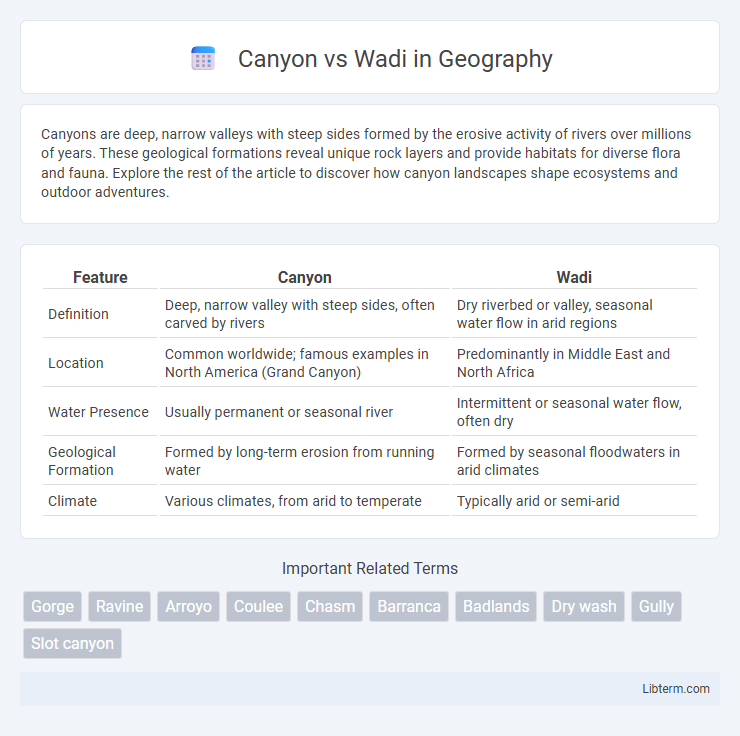Canyons are deep, narrow valleys with steep sides formed by the erosive activity of rivers over millions of years. These geological formations reveal unique rock layers and provide habitats for diverse flora and fauna. Explore the rest of the article to discover how canyon landscapes shape ecosystems and outdoor adventures.
Table of Comparison
| Feature | Canyon | Wadi |
|---|---|---|
| Definition | Deep, narrow valley with steep sides, often carved by rivers | Dry riverbed or valley, seasonal water flow in arid regions |
| Location | Common worldwide; famous examples in North America (Grand Canyon) | Predominantly in Middle East and North Africa |
| Water Presence | Usually permanent or seasonal river | Intermittent or seasonal water flow, often dry |
| Geological Formation | Formed by long-term erosion from running water | Formed by seasonal floodwaters in arid climates |
| Climate | Various climates, from arid to temperate | Typically arid or semi-arid |
Introduction to Canyons and Wadis
Canyons are deep, narrow valleys with steep sides, typically formed by river erosion over millions of years, creating dramatic landscapes often found in arid to semi-arid regions worldwide. Wadis, predominantly located in Middle Eastern and North African deserts, are dry riverbeds or valleys that experience occasional water flow during rare rainfall events, influencing local ecosystems and human settlement patterns. Both geological features highlight the dynamic interactions between water and land in shaping natural terrain, with canyons representing long-term erosion and wadis reflecting episodic water presence.
Defining Canyons: Characteristics and Formation
Canyons are deep, narrow valleys with steep sides, primarily formed by the long-term erosion of rock by rivers and streams. They are characterized by their impressive depth, dramatic cliffs, and rugged terrain, often exposing layers of geological history. Unlike wadis, which are dry riverbeds found mainly in arid regions, canyons contain permanent or seasonal water flows contributing to their continuous erosion and development.
What is a Wadi? Key Features Explained
A wadi is a dry riverbed or valley found predominantly in arid regions, characterized by intermittent water flow during rainy seasons. Key features include steep sides, temporary streams, and a landscape shaped by flash floods, making it distinct from permanently flowing canyons. Unlike canyons, which often have continuous water erosion, wadis remain dry for most of the year and serve as crucial water channels during rare precipitation events.
Geographic Distribution: Where Are Canyons and Wadis Found?
Canyons are primarily found in arid to semi-arid regions across North America, such as the Grand Canyon in the southwestern United States, and also in parts of South America, Asia, and Australia where river erosion shapes deep valleys. Wadis are typically located in Middle Eastern and North African deserts, including the Arabian Peninsula and the Sahara, formed by seasonal water flow in dry riverbeds. Both landforms illustrate distinct geographic distributions, with canyons linked to permanent river systems and wadis associated with intermittent streams in desert climates.
Geological Formation Processes: Canyon vs Wadi
Canyons form primarily through long-term river erosion cutting deep into bedrock, often in arid or semi-arid regions where water flow is concentrated, exposing layered sedimentary rock. Wadis are dry riverbeds or valleys formed by ephemeral streams that flow only during seasonal rains, carving shallow channels through erosion of softer sediments rather than hardened rock. The key geological distinction lies in canyons' extensive vertical incision into solid rock versus wadis' episodic water flow shaping loose alluvial deposits.
Climate and Environmental Conditions
Canyons typically form in arid or semi-arid climates where infrequent but intense rainfall causes rapid erosion, resulting in steep walls and deep gorges. Wadis, found primarily in desert regions like the Middle East and North Africa, remain dry most of the year but can experience flash floods during seasonal rains, shaping their flat-bottomed valleys. Both landscapes reflect extreme environmental conditions, with canyons often exposing geological strata and wadis serving as critical water channels during rare precipitation events.
Ecological Significance and Biodiversity
Canyons and wadis both serve as critical ecological habitats, with canyons often hosting unique microclimates that support diverse flora and fauna adapted to steep, rocky environments. Wadis, characterized by ephemeral water flow in arid regions, provide essential water sources that sustain high biodiversity during wet periods, supporting species adapted to intermittent hydration cycles. The ecological significance of canyons lies in their ability to preserve endemic species and create isolated ecosystems, while wadis function as biodiversity hotspots by enabling survival and reproduction of desert-adapted organisms.
Human Interaction and Cultural Importance
Canyons have historically served as natural fortifications and trade routes, fostering the development of settlements and cultural exchange along their ridges and floors. Wadis, typically found in arid regions, are vital for seasonal water collection, supporting agriculture and traditional nomadic lifestyles that shape local customs and rituals. Both landscapes influence human interaction by providing resources and sacred spaces that hold spiritual and social significance in regional cultures.
Notable Examples: Famous Canyons and Wadis Worldwide
The Grand Canyon in Arizona stands as a prominent example of canyons, showcasing vast, deeply eroded landscapes carved by the Colorado River. Wadis, such as Wadi Rum in Jordan, are distinguished by dry riverbeds or valleys that become seasonal water channels in arid climates, often featuring dramatic rock formations and historical significance. Both landforms highlight diverse geological processes and attract global interest for their unique natural beauty and cultural heritage.
Conclusion: Key Differences and Similarities
Canyons are deep, narrow valleys with steep sides, often formed by river erosion over millions of years, while wadis are dry riverbeds found in arid regions that only contain water during rare rainfall events. Both landforms share similar geological origins related to water erosion and serve as important ecological habitats. The primary distinction lies in the persistent water presence in canyons versus the typically dry conditions of wadis.
Canyon Infographic

 libterm.com
libterm.com